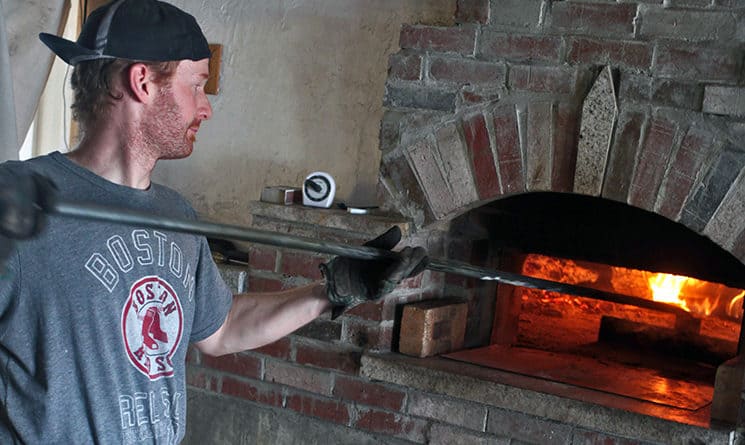Lionel Poilâne, the late world-renowned baker who committed to artisanal, old-world bread baking, once said, “What many bakers don’t realize is that good wheat can make bad bread. The magic of bread baking is in the manipulation and the fermentation. What has been lost … is this method.”
Today’s bakers seem to be rediscovering Poilâne’s method. Despite a strong gluten-free movement, small artisanal bakeries have opened and thrived throughout New Hampshire. Well-established bakeries have begun to use similar techniques. The trait they all share is a passion to learn and work with the art of naturally fermenting bread with wild yeast and bacteria.
In a little bakeshop in Canterbury, Dane Percy is surrounded by simple butcher’s block tables, baskets for bread rising, and lots of flour. Percy moves swiftly to shape his naturally fermented — or leavened — dough for its final rise.
“I was working as a research technician at UMass Dartmouth and was losing interest in my field, and I didn’t want to get a PhD. So I thought of changing my career somehow,” says Percy, recalling his introduction to the baking world. “After a lot consulting with myself, it was bread baking.”
He got a job in a bakery that made organic, all-natural, leavened bread in brick ovens, and worked there for four years. “It just seemed so right the whole time, I never really asked for more, and that’s what I still do now,” he says.
Above and at top: Dane Percy baking bread at Canterbury Bread Shop
Percy bakes 450 to 600 loaves of bread a week for statewide farmers markets and the CSA he offers through Brookford Farm. Like Poilâne, his method is focused on the process of natural fermentation.
“Fermentation, in every setting, is just the breakdown of carbon by microorganisms,” he says. “It’s letting the bacteria and the yeast that are naturally present around us ferment grain. By ferment, I mean eat, and when bacteria and yeast eat bread they make amazing things like carbon dioxide, alcohols, and esters, and all these compounds that give (bread) flavors and volume.”
David Anderson, manager of Ceres Bakery, introduced naturally fermented bread to the downtown Portsmouth eatery just over a year ago.
“Basically, I had always wanted to figure out how to do it,” Anderson says. “As a baker, you are always trying to figure things out, but you get to the point where you want to do something else. Each bread has its own challenge to it, and once you figure that out, you want to learn more breads.”
Anderson says he takes inspiration from bread books, including “Tartine Bread” by Chad Robertson, co-owner of Tartine Bakery in San Francisco.
“(Robertson) was very into the history and the science of bread. He really got into the details of what’s going on, which you need for the naturally leavened stuff because it’s a very fickle thing,” Anderson says. “You realize when you’re doing loaf bread with commercial yeast how controlled an experience that is. Even though you’re basically doing the same thing (with naturally leavened bread), it’s much more unpredictable.”
“People like to knit their own hats and like to know their bread is real.” — David Anderson
of Ceres Bakery
Anderson adapted a few of the Tartine recipes to try at Ceres, and he’s never gone back, as far as personal taste is concerned. The shift was not without its challenges; Ceres is not climate-controlled, and naturally leavened bread — or “’natches,” as his bakers call them — have their own learning curve.
“Any bread product has risk. You’re dealing with a living thing,” he says. “There are a lot of variables that could go wrong, like how long we left the starter out, if the fridge is at the right temperature, how hot was the water, how long was it on the table. There are so many questions, you can definitely mess it up. But, to me, that’s the cool part. It’s hard to get it right and definitely worth it.”
Leaven, a Somersworth restaurant committed to craft beer and naturally leavened sourdough bread, has built its entire business on the concept of fermentation.
“I had many preconceived — and incorrect — ideas about sourdough bread, but learning about the variety of flavors, crumbs, and techniques opened my mind,” says Leaven co-owner Emmett Soldati. “Once you learn the ropes of sourdough, it’s very simple. … It’s kind of like learning a musical instrument: It soon becomes a natural process. Sourdough teaches patience.”
flouring a shaped, rising loaf
Leaven’s head baker, Brenn Jaworoski, says the key ingredient to the sourdough is its starter.
“A starter is simply water and flour that, over time, creates natural yeast,” he explains. “From our base starter, we build our pre-ferment and allow it 24 hours to mature before baking with it. Our breads are mixed and baked in the same day. Our bakers start their shifts anywhere from 8 p.m. to 2 a.m. to allow the breads the proper amount of time to rise.”
Although the process is long and demanding, Jaworoski says it’s necessary to produce the finest bread possible.
“We have decided to take on the sourdough challenge because we believe it creates an untouchable and unique result,” he says.
There is a shared pride and tenacity between the Seacoast bakers pursuing wild yeast fermentation.
“People like to knit their own hats and like to know their bread is real,” says Anderson. “It’s always something I personally have been really into. People have been eating bread and sharing it for thousands of years. I think it is a real tradition. I like to think this is a next evolution, like organic food.”

